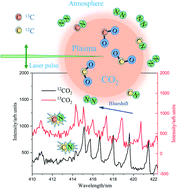The online detection of carbon isotopes by laser-induced breakdown spectroscopy
Abstract
The study of the carbon cycle is profound to the global ecosystem. In this paper, isotopic spectroscopy based on laser-induced breakdown spectroscopy (LIBS) was applied to the online detection of carbon isotopes and the study of atmospheric carbon cycle. The emission of carbon dioxide in the atmosphere was simulated by using a laser beam to ablate the coal, wood and paper samples. The emission spectra of smoke showed that carbon dioxide in the smoke could be detected online by the analysis of the molecular spectrum of the CN radicals. Then, taking urea as a carbon isotope sample, the isotopic shifts in the CN molecular spectra were clearly observed. The emission band of the (1,0) transition occurs red-shift of about 0.6 nm, while the emission band of the (0,1) transition appears blue-shift of about 0.8 nm. Furthermore, gaseous 13CO2 was directly detected by LIBS and the isotopic shifts in the CN bands from CO2 were also measured. Moreover, the energy differences in the isotopic shifts of the CN emission bands were calculated based on the density functional theory with the B3PW91/6-31+G(d) basis set, and the calculation results were basically consistent with the experimental values. Finally, the wavelength shifts for all the six different combinations of carbon and nitrogen isotopes were calculated. All the results indicate that the LIBS technique combined with an isotope spectrum is a promising and effective online detection method of gaseous carbon isotopes.


 Please wait while we load your content...
Please wait while we load your content...